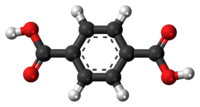
Photo from wikipedia
The synergistic mechanism of Ni catalyst and supercritical water (SCW) during the treatment of dibutyl phthalate (DBP), a representative component of refractory phthalic acid esters, has been investigated using the… Click to show full abstract
The synergistic mechanism of Ni catalyst and supercritical water (SCW) during the treatment of dibutyl phthalate (DBP), a representative component of refractory phthalic acid esters, has been investigated using the ReaxFF molecular dynamic simulations. During the catalytic SCW gasification process, Ni catalyst could facilitate the bond cleavage while the roles of SCW were to promote cracking and serve as H sources. As for the evolution of dissociated side chains, the cooperative effects greatly enhanced the cracking of long-chain fragments and generation of saturated products. Ni could help split H2O and the SCW accelerated β-scission as well as provided H and O atoms. For the aromatic ring-opening stage, a Ni-catalyzed process involved successive bond scission and migration of carbon chains into catalyst bulk was dominant while the SCW only offered marginal help. With regard to H2 production, the synergistic effects were supposed to improve H2 yield. Furthermore, the Ni catalyst was gradually deactivated...
Journal Title: Industrial & Engineering Chemistry Research
Year Published: 2019
Link to full text (if available)
Share on Social Media: Sign Up to like & get
recommendations!